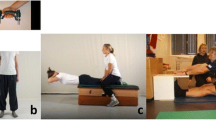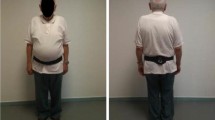Abstract
Objective
This study verified if the phase angle (PA) formed by the resistance (R) and reactance (Xc) obtained from bioimpedance (BIA) might be a useful tool to identify functionality.
Design and Participants
It was conducted a cross-sectional study with 152 women ≥ 65 years old from the community.
Measurements
Weight, height, body mass index (BMI), calf circumference (CC), hand grip strength (HGS), gait speed (GS), fat free mass (FFM), body fat (BF), PA with R and Xc from the BIA were measured. Spearman’s and Pearson’s correlations and the odds ratio (OR) were performed using the IBM SPSS software version 22.0.
Results
Sixty-four percent (n=98) women are with PA below the reference. Negative moderate significant correlation was found between PA and age (r =−0.440*; p<0.001). Moderate significant correlation was observed between PA and GS (r = 0.484**; p<0.001). Weak significant correlation was found between PA and HGS (r = 0.177*; p = 0.029). Odds ratio (OR) demonstrated that individuals with PA above the mean value have 4.77 times more chances of having increased GS (confidence interval 2.40–9.48; 95%). Women aged below the mean value have 4.02 times more chances of having higher PA (confidence interval 2.02–7.99; 95%). Younger aged women showed 4.02 times more chances of having higher PA (confidence interval 2.02–7.99; 95%).
Conclusions
Phase angle can be associated with functional tests, such as gait speed and hand grip strength, in older women.
Similar content being viewed by others
References
World Health Organization. Ageing and Health: key facts 2018. http://www.who.int/news-room/fact-sheets/detail/ageing-and-health. Accessed September 9, 2018.
Morley JE, Haren MT, Rolland Y, Kim MJ. Frailty. Med Clin N Am. 2006; 90: 837–847.
Wilhelm-Leen ER, Hall YN, Horwitz RI, Chertow GM. Phase Angle, Frailty and Mortality in Older Adults. J Gen Intern Med. 2013;29(1):147–54.
Morley JE, Vellas B, Abellan van Kan G, Anker SD, Bauer JM, Bernabei R et al. Frailty Consensus: A Call to Action. J Am Med Dir Assoc. 2013;14(6):392–397.
Campos ACV, Almeida MHM, Campos GV, Bogutchi TF. Prevalência de incapacidade funcional por gênero em idosos brasileiros: uma revisão sistemática com metanálise. Rev. Bras. Geriatr. Gerontol., 2016; 19(3):545–559.
Fernandez-Bolaños M, Otero A, Zunzunegui MV, Beland F, Alarcón T, de Hoyos C et al. Sex differences in the prevalence of frailty in a population aged 75 and older in Spain. J Am Geriatric Soc. 2008;36(12):2370–1.
Barbosa-Silva MCG, Barros AJD, Wang J, Heymsfield SB, Pierson Jr RN. Bioelectrical impedance analysis: population reference values for phase angle by age and sex. Am J Clin Nutr. 2005;82:49–52.
Norman K, Stobäus N, Pirlich M, Bosy-Westphal A. Bioelectrical phase angle and impedance vector analysis - Clinical relevance and applicability of impedance parameters. Clinical Nutrition. 2012 3(6):854–861.
Cruz-Jentoft AJ, Bahat G, Bauer J, Boirie Y, Bruyère O, Cederholm T et al. Sarcopenia: revised European consensus on definition and diagnosis. Age and Ageing. 2019 48(1):16–31.
Basilea C, Della-Morteb D, Cacciatorea F, Gargiuloe G, Galiziaa G, Roselli M et al. Phase angle as bioelectrical marker to identify elderly patients at risk of sarcopenia. Experimental Gerontology. 2014;58:43–46.
World Health Organization. Obesity: preventing and managing the global epidemic. Geneva: WHO; 1998.
World Health Organization. Physical status: the use and interpretation of anthropometry. Geneva: World Health Organization; 1995. (Technical Report Series, 854).
Barbosa-Silva TG, Bielemann RM, Gonzalez MC, Menezes AMB. Prevalence of sarcopenia among community-dwelling elderly of a medium-sized South American city: results of the COMO VAI? Study. J Cachexia Sarcopenia Muscle. 2016;7(2):136–43.
Fess EE, Moran CA. Grip strength. Clinical assessment recommendations. American Society of Hand Therapists. 1992;41–45.
Karpman C, LeBrasseur NK, DePew ZS, Novotny PJ, Benzo RP. Measuring Gait Speed in the Out-Patient Clinic: Methodology and Feasibility. Respiratory Care. 2014;59(4):531–537.
Kylea UG, Bosaeusb I, De Lorenzo AD, Deurenberg P, Elia M, Gómez JM et al. Espen guidelines: Bioelectrical impedance analysis-part I: review of principles and methods. Clin Nutr. 2004;23(5):1226–1243.
Kylea UG, Bosaeusb I, De Lorenzoc AD, Elia M, Gómez JM et al. Espen guidelines: Bioelectrical impedance analysis-part II: utilization in clinical practice. Clin Nutr 2004;23(6):1430–53.
Farias CLA, Campos DJ, Bonfin CMS, Vilela RM. Phase angle from BIA as a prognostic and nutritional status tool for children and adolescents undergoing hematopoietic stem cell transplantation. Clinical Nutrition. 2013;32:420–425.
Bansal N, Zelnick LR, Himmelfarb J, Chertow GM. Bioelectrical Impedance Analysis Measures and Clinical Outcomes in CKD. American Journal of Kidney Diseases. 2018;72(5):662–672.
Zilles M, Betz C, Jung O, Gauer S, Hammerstingl R, Wächtershäuser A el al. How to prevent renal cachexia? a clinical randomized pilot study testing oral supplemental nutrition in hemodialysis patients with and without human immunodeficiency virus infection. Journal of Renal Nutrition. 2018;28(1):37–44.
Fried LP, Tangen CM, Walston J, Newman AB, Hirsch C, Gottdiener J et al. Frailty in Older Adults: Evidence for a Phenotype. Journal of Gerontology: MEDICAL SCIENCES. 2001;56(3):M146–M156.
Freire Junior RC, Porto JM, Rodrigues NC, Brunelli, RM, Braga LFP, Abreu DCC. Spatial and temporal gait characteristics in pre-frail community-dwelling older adults. Geriatr Gerontol Int. 2016;16:1102–1108.
Kilic MK, Kizilarslanoglu MC, Arik G, Bolayir B, Kara O, Dogan V et al. Association of Bioelectrical Impedance Analysis-Derived Phase Angle and Sarcopenia in Older Adults. Nutr Clin Pract. 2017;32:103–109.
Liguori I, Curcio F, Russo G, Cellurale M, Aran L, Bulli G et al. Risk of Malnutrition Evaluated by Mini Nutritional Assessment and Sarcopenia in Noninstitutionalized Elderly People. Nutr Clin Pract. 2018;33:879–886.
Bosy-Westphal A, Danielzik S, Dorhofer RP, Later W, Wiese S, Muller MJ. Phase angle from bioelectrical impedance analysis: population reference values by age, sex, and body mass index. JPEN J Parenter Enteral Nutr. 2006;30(4): 309–16.
Gonzalez MC, Barbosa-Silva TG, Bielemann RM, Gallagher D, Heymsfield SB. Phase angle and its determinants in healthy subjects: influence of body composition. Am J Clin Nutr. 2016;103:712–6.
Norman K, Stobäus N, Pirlich M, Bosy-Westphal A, Szramek A, Scheufele R et al. Cutoff percentiles of bioelectrical phase angle predict functionality, quality of life, and mortality in patients with cancer. Am J Clin Nutr. 2010;92:612–9.
Sousa-Santosa AR, Afonso C, Moreira P, Padrão P, Santos A, Borges N et al. Weakness: The most frequent criterion among pre-frail and frail older Portuguese. Archives of Gerontology and Geriatrics. 2018;74:162–168.
Sergi G, De Rui M, Stubbs B, Veronese N, Manzato E. Measurement of lean body mass using bioelectrical impedance analysis: a consideration of the pros and cons. Aging Clinical and Experimental Research. 2016;29(4):591–597.
Acknowledgments
The authors are grateful to the grants from National Council for Scientific and Technological Development (CNPq/306179/2016-4). We also thank the Clinic Hospital of Federal University of Parana (UFPR). This study was financed in part by the Coordenação de Aperfeiçoamento de Pessoal de Nível Superior - Brasil (CAPES) - Finance Code 001.
Author information
Authors and Affiliations
Corresponding author
Ethics declarations
Ethicals standards: This study was approved by the Ethical Committee of Clinics Hospital Complex, Federal University of Paraná (approval number: CAAE 58865916.8.0000.0096) and complied with the tenets of the Declaration of Helsinki.
Additional information
Conflict of Interest: The authors report no conflict of interest.
Rights and permissions
About this article
Cite this article
Bittencourt, D.C.D., Schieferdecker, M.E.M., Macedo, D.S. et al. Phase Angle Reflects Loss of Functionality in Older Women. J Nutr Health Aging 24, 251–254 (2020). https://doi.org/10.1007/s12603-020-1324-5
Received:
Accepted:
Published:
Issue Date:
DOI: https://doi.org/10.1007/s12603-020-1324-5




